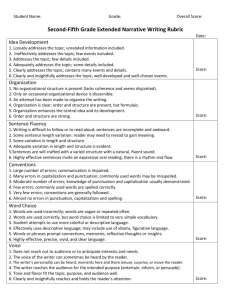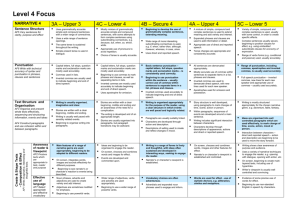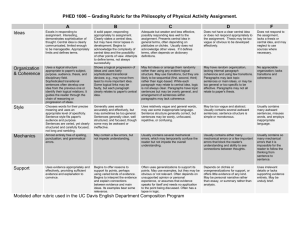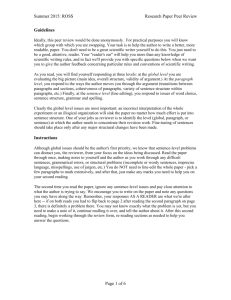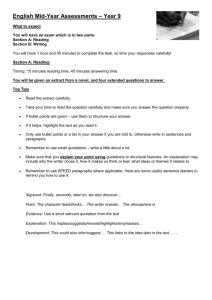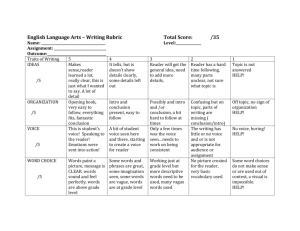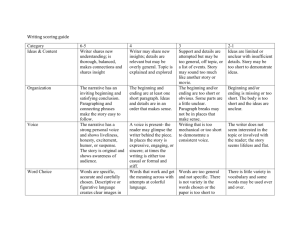Level 5 Focus Combined
advertisement
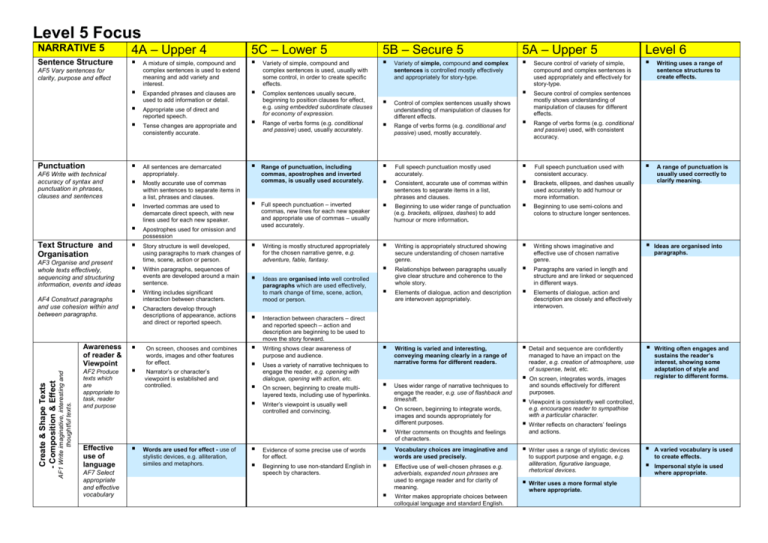
Level 5 Focus NARRATIVE 5 4A – Upper 4 5C – Lower 5 5B – Secure 5 5A – Upper 5 Level 6 Sentence Structure AF5 Vary sentences for clarity, purpose and effect Punctuation AF6 Write with technical accuracy of syntax and punctuation in phrases, clauses and sentences Text Structure and Organisation AF3 Organise and present whole texts effectively, sequencing and structuring information, events and ideas AF4 Construct paragraphs and use cohesion within and between paragraphs. AF1 Write imaginative, interesting and thoughtful texts. Create & Shape Texts - Composition & Effect Awareness of reader & Viewpoint AF2 Produce texts which are appropriate to task, reader and purpose A mixture of simple, compound and complex sentences is used to extend meaning and add variety and interest. Expanded phrases and clauses are used to add information or detail. Appropriate use of direct and reported speech. Tense changes are appropriate and consistently accurate. All sentences are demarcated appropriately. Mostly accurate use of commas within sentences to separate items in a list, phrases and clauses. Inverted commas are used to demarcate direct speech, with new lines used for each new speaker. Apostrophes used for omission and possession Story structure is well developed, using paragraphs to mark changes of time, scene, action or person. Within paragraphs, sequences of events are developed around a main sentence. Writing includes significant interaction between characters. Characters develop through descriptions of appearance, actions and direct or reported speech. On screen, chooses and combines words, images and other features for effect. Narrator’s or character’s viewpoint is established and controlled. Variety of simple, compound and complex sentences is used, usually with some control, in order to create specific effects. Complex sentences usually secure, beginning to position clauses for effect, e.g. using embedded subordinate clauses for economy of expression. Range of verbs forms (e.g. conditional and passive) used, usually accurately. Range of punctuation, including commas, apostrophes and inverted commas, is usually used accurately. Full speech punctuation – inverted commas, new lines for each new speaker and appropriate use of commas – usually used accurately. Writing is mostly structured appropriately for the chosen narrative genre, e.g. adventure, fable, fantasy. Ideas are organised into well controlled paragraphs which are used effectively, to mark change of time, scene, action, mood or person. AF7 Select appropriate and effective vocabulary Words are used for effect - use of stylistic devices, e.g. alliteration, similes and metaphors. Control of complex sentences usually shows understanding of manipulation of clauses for different effects. Range of verbs forms (e.g. conditional and passive) used, mostly accurately. Full speech punctuation mostly used accurately. Consistent, accurate use of commas within sentences to separate items in a list, phrases and clauses. Beginning to use wider range of punctuation (e.g. brackets, ellipses, dashes) to add humour or more information. Writing is appropriately structured showing secure understanding of chosen narrative genre. Relationships between paragraphs usually give clear structure and coherence to the whole story. Elements of dialogue, action and description are interwoven appropriately. Secure control of variety of simple, compound and complex sentences is used appropriately and effectively for story-type. Writing uses a range of sentence structures to create effects. Secure control of complex sentences mostly shows understanding of manipulation of clauses for different effects. Range of verbs forms (e.g. conditional and passive) used, with consistent accuracy. Full speech punctuation used with consistent accuracy. Brackets, ellipses, and dashes usually used accurately to add humour or more information. A range of punctuation is usually used correctly to clarify meaning. Beginning to use semi-colons and colons to structure longer sentences. Writing shows imaginative and effective use of chosen narrative genre. Ideas are organised into paragraphs. Paragraphs are varied in length and structure and are linked or sequenced in different ways. Elements of dialogue, action and description are closely and effectively interwoven. Interaction between characters – direct and reported speech – action and description are beginning to be used to move the story forward. Writing shows clear awareness of purpose and audience. Uses a variety of narrative techniques to engage the reader, e.g. opening with dialogue, opening with action, etc. On screen, beginning to create multilayered texts, including use of hyperlinks. Writer’s viewpoint is usually well controlled and convincing. Effective use of language Variety of simple, compound and complex sentences is controlled mostly effectively and appropriately for story-type. Evidence of some precise use of words for effect. Beginning to use non-standard English in speech by characters. Writing is varied and interesting, conveying meaning clearly in a range of narrative forms for different readers. Detail and sequence are confidently Uses wider range of narrative techniques to engage the reader, e.g. use of flashback and timeshift. On screen, beginning to integrate words, images and sounds appropriately for different purposes. Writer comments on thoughts and feelings of characters. Vocabulary choices are imaginative and words are used precisely. Effective use of well-chosen phrases e.g. adverbials, expanded noun phrases are used to engage reader and for clarity of meaning. Writer makes appropriate choices between colloquial language and standard English. managed to have an impact on the reader, e.g. creation of atmosphere, use of suspense, twist, etc. On screen, integrates words, images and sounds effectively for different purposes. Writing often engages and sustains the reader’s interest, showing some adaptation of style and register to different forms. Viewpoint is consistently well controlled, e.g. encourages reader to sympathise with a particular character. Writer reflects on characters’ feelings and actions. Writer uses a range of stylistic devices to support purpose and engage, e.g. alliteration, figurative language, rhetorical devices. Writer uses a more formal style where appropriate. A varied vocabulary is used to create effects. Impersonal style is used where appropriate. NARRATIVE 5 4A – Upper 4 5C – Lower 5 5B – Secure 5 5A – Upper 5 Level 6 Word Structure & Spelling AF8 Use correct spelling Accurate spelling of polysyllabic words that conform to regular patterns. Presentation & Handwriting Regular handwriting style which is consistently fluent, joined and legible. Letters and words are appropriate in size and position. Selects appropriate ICT programme from a variety of programmes to present written work effectively. Plausible attempts to spell words with complex regular patterns. Beginning to use a range of appropriate strategies to edit, proofread and correct spelling in own work, on paper and on screen. Handwriting is joined, clear and fluent, and is beginning to be adapted to different tasks. Letters and words are consistently appropriately placed. Beginning to develop a personal legible style. Uses a range of presentational devices on screen to present own work. Spelling of words with complex regular patterns is usually accurate. Uses a range of appropriate strategies to edit, proofread and correct spelling in own work, on paper and on screen. Handwriting is joined, clear and fluent and, where appropriate, is adapted to a range of tasks. Beginning to establish a consistent and personal legible style. Uses a range of presentational devices on screen to present own work appropriately. Spelling of words with complex regular patterns is mostly accurate. Effective use of a range of appropriate strategies to edit, proofread and correct spelling in own work, on paper and on screen. Handwriting is consistently joined, clear and fluent, with appropriate adaptation to reflect the demands of the task. Spelling is generally accurate, including that of irregular words. Handwriting is neat and legible. Handwriting maintains a personal style to engage the reader. Uses a range of presentational devices on screen to present own work effectively. NON-NARRATIVE 5 4A – Upper 4 5C – Lower 5 5B – Secure 5 5A – Upper 5 Level 6 Text Structure and Organisation AF3 Organise and present whole texts effectively, sequencing and structuring information, events and ideas AF1 Write imaginative, interesting and thoughtful texts. Create & Shape Texts - Composition & Effect AF4 Construct paragraphs and use cohesion within and between paragraphs. Awareness of reader & Viewpoint AF2 Produce texts which are appropriate to task, reader and purpose Writing shows consistently effective use of the structure of the chosen non-fiction text type. Provides thorough coverage of main points and usually appropriate balance and emphasis. A widening range of layout conventions and presentational devices are used to indicate main and supporting points. Secure and effective use of the chosen text type to establish context and purpose of writing. Ideas are usually organised into appropriately sequenced sections or paragraphs which lead to a well-drawn conclusion. Each section/paragraph has a clear focus around which content is organised. AF7 Select appropriate and effective vocabulary Blue Ideas are mostly organised into appropriately sequenced sections or paragraphs which contribute to the overall effectiveness and shape of the text. Within sections /paragraphs ideas are clearly developed or explained, including relevant detail. Writing shows mostly appropriate adaptation of features of chosen form to meet the purpose of the task or for a specific audience. On screen, chooses and combines words, images and other features for effect. Writer’s viewpoint is established and controlled. Writing shows consistently appropriate adaptation of features of chosen form to meet the purpose of the task or for a specific audience. Conclusion may attempt to relate subject to reader or make direct appeal to reader. On screen, beginning to create multilayered texts, including use of hyperlinks. Viewpoint is usually well convincing. controlled and Effective use of language Controlled use of structure across the whole piece which maintains and emphasises the context and purpose of writing. Words are used for effect - use of stylistic devices, e.g. alliteration, similes and metaphors. Effective use of technical and precise vocabulary for effect, e.g. to inform, persuade, explain, etc. Precise, varied and technical vocabulary are used effectively to support the writer’s purpose, clarify meaning or add interest. Non-standard English, e.g. use of colloquialism or dialect, where used, is usually appropriate. = National Curriculum Level Descriptors Writing is varied and interesting, conveying meaning clearly in a range of forms for different readers. Some evidence of direct attempts to interest, inform, involve or appeal to the reader. On screen, beginning to integrate words, images and sounds appropriately for different purposes. Viewpoint is mostly well controlled and convincing. Vocabulary choices are imaginative and words are used precisely. Well-chosen phrases e.g. adverbials, expanded noun phrases are used for effect and clarity of meaning. Writing uses a more formal style where appropriate. Writing shows imaginative and effective use of chosen text type. Ideas are organised into paragraphs. Provides thorough coverage of full range of relevant information covered in appropriate detail. Paragraphs are varied in length and structure and are linked or sequenced in a variety of ways. Transition between sections is usually well controlled. Appropriate layout conventions and presentational devices are selected and used consistently. Writing shows sustained awareness of the reader, e.g. appropriate and convincing attempts to interest, inform, involve or appeal to the reader. Writing often engages and sustains the reader’s interest, showing some adaptation of style and register to different forms. On screen, integrates words, images and sounds effectively for different purposes. Viewpoint is consistently well controlled and convincing, e.g. writer commenting on events, acknowledging different points of view. Writer uses a range of stylistic devices to support purpose and engage, e.g. alliteration, figurative language, rhetorical devices. Impersonal or formal style, where used, is usually sustained and appropriate. A varied vocabulary is used to create effects. Impersonal style is used where appropriate.

